
Hexen: Beyond Heretic is a fantasy first-person shooter video game developed by Raven Software and published by id Software distributed through GT Interactive on October 30, 1995. It is the sequel to 1994's Heretic, and the second game in Raven Software's "Serpent Riders" trilogy, which culminated with Hexen II. The title comes from the German noun Hexen, which means "witches", and/or the verb hexen, which means "to cast a spell". Game producer John Romero stated that a third, unreleased game in this series was to be called Hecatomb.

Earthworm Jim is a 1994 run and gun platform game developed by Shiny Entertainment, featuring an earthworm named Jim, who wears a robotic suit and battles the forces of evil. The game was released for the Sega Genesis and Super Nintendo Entertainment System, before being subsequently ported to several other video game consoles.

The 3-D Battles of WorldRunner, originally released in Japan as Tobidase Daisakusen, is a 1987 third-person rail shooter platform video game developed and published by Square for the Family Computer Disk System. It was later ported to cartridge format and published by Acclaim for the Nintendo Entertainment System.

Turok: Dinosaur Hunter is a first-person shooter video game developed by Iguana Entertainment and published by Acclaim for the Nintendo 64 console and Microsoft Windows. It was released in 1997 in North America and Europe. Turok is an adaptation of the Valiant Comics comic book series of the same name. The player controls Turok, a Native American warrior, who must stop the evil Campaigner from conquering the universe with an ancient and powerful weapon.

X-Men: Children of the Atom is an arcade game developed and published by Capcom and released on the CP System II arcade hardware in 1994 in Japan and in 1995 in North America and Europe.
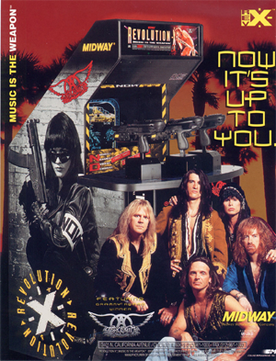
Revolution X is a shooting gallery video game developed by Midway and released in arcades in 1994. The gameplay is similar to Midway's earlier Terminator 2: Judgment Day, but is themed around the band Aerosmith. The oppressive New Order Nation regime and their leader Helga have abducted Aerosmith, and players use a mounted gun to control onscreen crosshairs and shoot enemies. The members of Aerosmith are hidden throughout the game's international locales and must be found in order to receive the game's true ending.

Batman Forever: The Arcade Game is a beat 'em up video game based on the movie Batman Forever. The subtitle is used to differentiate it from Batman Forever, another beat 'em up published by Acclaim at around the same time. One or two players, playing as Batman and Robin, fight Two-Face, the Riddler, and numerous henchmen.

Puzzle Bobble 2 is a tile-matching video game by Taito. The first sequel to Puzzle Bobble, it is also known in Europe and North America as Bust-A-Move Again for arcades and Bust-A-Move 2: Arcade Edition for home consoles. Released into the arcades in 1995, home conversions followed for the PlayStation, Sega Saturn, Nintendo 64, and Windows platforms. The game was included in Taito Legends 2, but the US arcade version was included in the US PS2 version instead. Further ports for the Nintendo Switch, PlayStation 4, and Xbox One were released by City Connection alongside Puzzle Bobble 3 in February 2023.

Rise 2: Resurrection is a fighting game developed by Mirage Media and published by Acclaim Entertainment in 1996. The game is a sequel to Rise of the Robots, and improves on the first game's graphics, rendering, and animation; hits give off metal scraps and electrical arcs progressively run over the bodies of damaged robots.

Rapid Reload, known in Japan as Gunners Heaven (ガンナーズヘヴン), is a 1995 run and gun video game developed by Media.Vision and published by Sony Computer Entertainment for the PlayStation. It was released in both Japan and Europe in 1995. The game was re-released on the PlayStation Network in Japan in 2007 and in Asia in 2010.
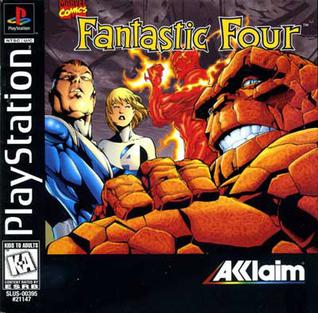
Fantastic Four is a PlayStation video game developed by Probe Entertainment and published by Acclaim Entertainment. The game was released in 1997, and is based on the Marvel Comics characters of the same name.

Batman Forever is a beat 'em up video game based on the film of the same name. Though released by the same publisher at roughly the same time, it is an entirely different game from Batman Forever: The Arcade Game. The game was followed by Batman & Robin in 1998.

South Park is a first-person shooter video game based on the American animated sitcom of the same name. The game was developed by Iguana Entertainment, using a modified version of the engine used in the Acclaim Entertainment-published Turok 2: Seeds of Evil; both games shared the same publisher and were released for the Nintendo 64 in 1998 in North America, and for Microsoft Windows in 1999. South Park was released in Europe and ported to the PlayStation in the latter year to coincide with the film South Park: Bigger, Longer & Uncut.
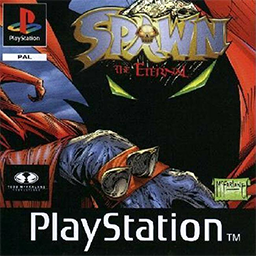
Spawn: The Eternal is an action-adventure video game developed by Sony Interactive Studios America and published by Sony Computer Entertainment for the PlayStation, based on the comic book character Spawn created by Todd McFarlane and produced by Image Comics. It was released on December 9, 1997 in North America and received poor reviews. When played on a CD player, the disc would be revealed to contain a lengthy audio interview with Spawn creator Todd McFarlane.
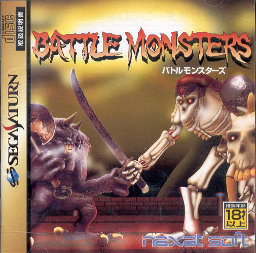
Battle Monsters (バトルモンスターズ) is a versus fighting game developed by Scarab for the Sega Saturn. It was originally published by Naxat Soft in Japan and later published in North America and Europe by Acclaim Entertainment. Similar to Atari's Pit-Fighter, the game makes heavy use of digitized human actors as the characters, plus some blood influenced by Midway's Mortal Kombat series. The game features 12 playable fighters, and plays out on multi-tiered stages.
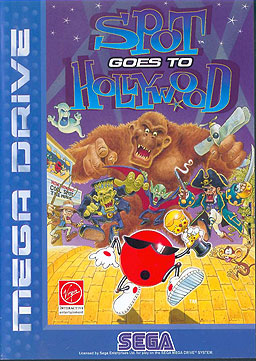
Spot Goes to Hollywood is a platform game developed by Eurocom and published by Acclaim Entertainment in North America and Virgin Interactive Entertainment in Europe for the Mega Drive/Genesis as the sequel to Cool Spot. Saturn and PlayStation versions were later released with full-motion video clips and isometric graphics. The player controls Spot, the mascot of the 7 Up soft drink, as he travels to various places trying to free his friends.

The Crow: City of Angels is a 1997 action video game for Sega Saturn, PlayStation and Microsoft Windows. It is loosely based on the movie of the same title. The player assumes the role of the hero of the film, Ashe Corven. The game was developed by Gray Matter, whose previous game was Perfect Weapon, which The Crow: City of Angels closely resembles in its basic mechanics. It was met with negative reviews.
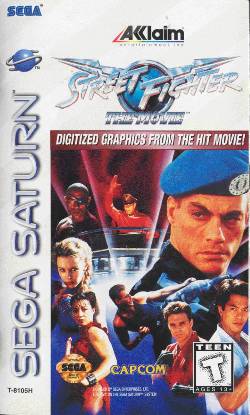
Street Fighter: The Movie is a 2D head-to-head fighting game developed by Capcom, released for the PlayStation and Sega Saturn in 1995, with the game serving as a North American launch title for the PlayStation. The game is based on the 1994 live-action Street Fighter movie, itself based on the Street Fighter series of fighting games, and uses digitized images of the film's cast as the characters. While it shares its title with the arcade game Street Fighter: The Movie, the home version is not a port but a similar game developed on the same premise. The game was a commercial success, but received widespread negative reception.

Cutthroat Island is platform game based on 1995 film of the same name that was developed by Software Creations and published by Acclaim Entertainment in 1995 for the Game Boy, Game Gear, Genesis, and Super Nintendo Entertainment System. When the game was first released, it featured a promotion by which players could find hidden treasure chests in the game and enter a contest to win real world prizes.

Iron & Blood: Warriors of Ravenloft is a 3D fighting game released for PC and PlayStation.



















